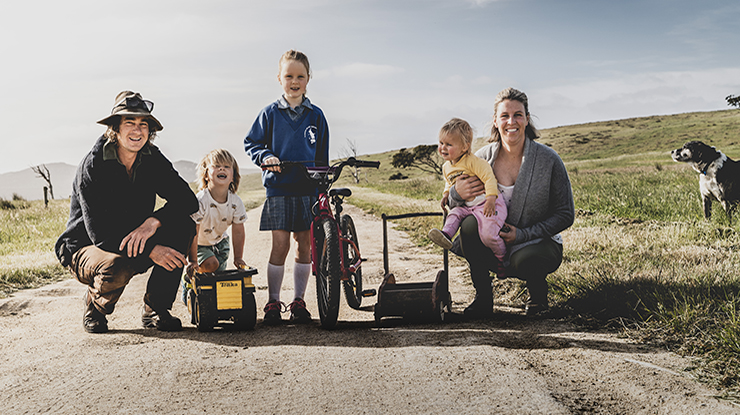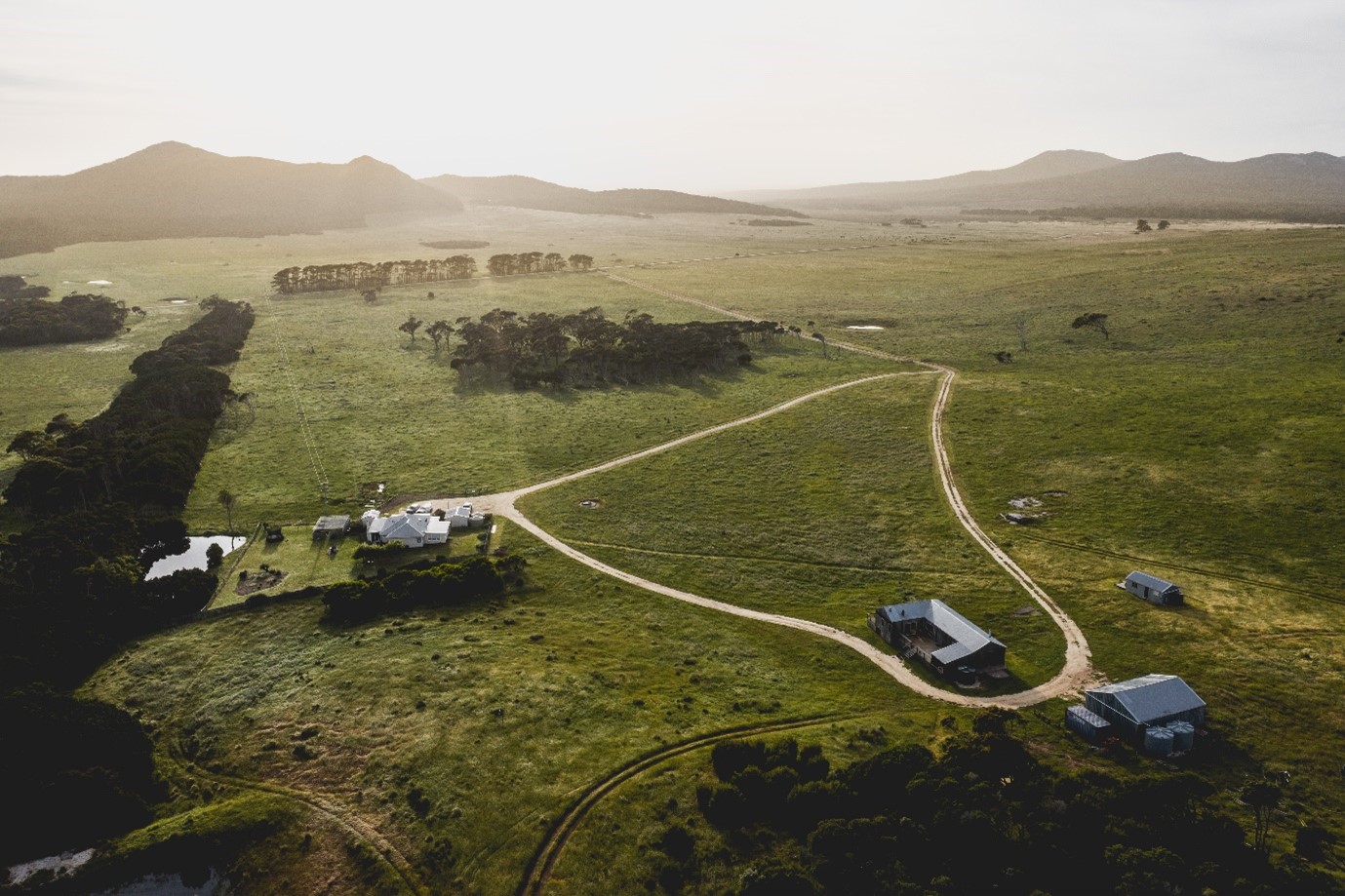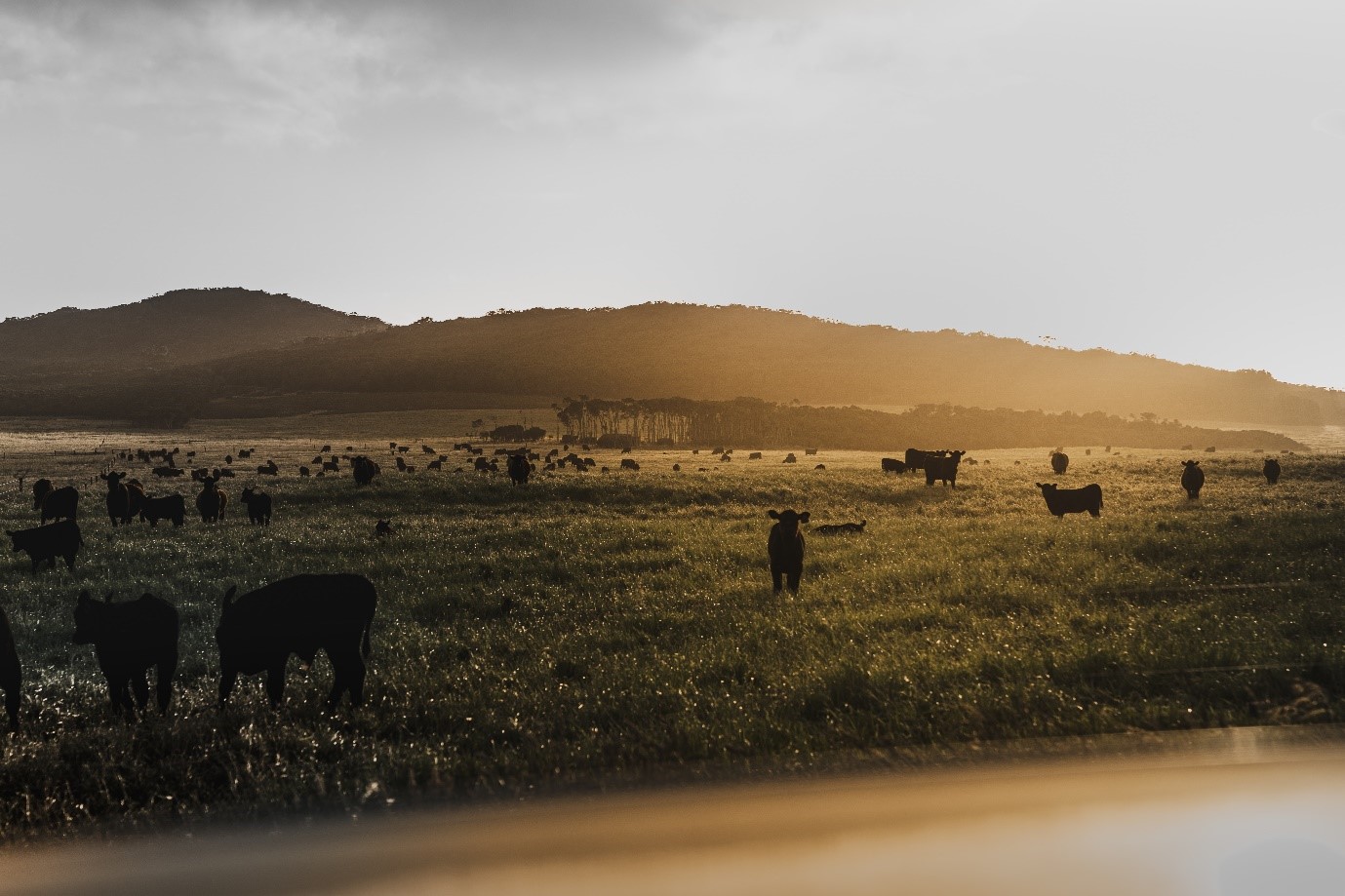
Simplicity backs island enterprise
Flinders Island beef producers Tom and Jo Youl with their children (from left) Billy, Alice and Georgie.
Image: Joe Chelkowski.
Running a beef enterprise across two farms plus tourism and hospitality ventures on Flinders Island sounds anything but simple, especially with three young children – but Tom and Jo Youl have focused on simplicity as a guiding principle when designing their farm business model.
Tom and Jo opened their front gate as part of a virtual farm tour for the 2021 Tasmanian Red Meat Updates conference, to give an insight into life and red meat production on the Bass Strait island.
They run 800 Angus breeders on ‘The Quoin’, the northern-most farm on the island, and raise weaners on a second property 20km south, ‘Tilba’, which they purchased two years ago.
Tom manages the farms and Jo is responsible for accommodation, restaurant and tourism ventures in nearby Killiecrankie and Whitemark, as well as on-farm accommodation on The Quoin.
The Quoin’s original homestead block has been in Jo’s family since 1932 – with a break of several years as part of the soldier settlement program. A builder by trade, Tom hails from a Merino farm in the Tasmanian midlands. He was already planning a move to Flinders Island in 2011 when he met Jo, who was working in marketing in Melbourne.
In 2014 the pair took over The Quoin. Over the next few years they purchased about 600ha of adjoining land and began a major redevelopment process.
Their redevelopment program has encompassed:
Soon after taking over the farm, Tom joined a benchmarking group run by Holmes Sackett, now Aggregate Consulting.
“I got a lot out of the group, especially in the first year or two when I was learning about cattle and farming on the island,” Tom said.
“It helped me make a lot of decisions which have lifted my business from 20% to 80% productivity.
“It’s going to be harder to achieve the next 10–20% of gains – it will be tinkering around the edges rather than big, structural fixes.”
One of Tom’s key performance indicators for the enterprise over the next 5–10 years is to increase stocking rate by 1–2 dry sheep equivalent per hectare (DSE/ha) per year, which will increase preg-tested in calf breeder numbers to about 850 next year.
About three years ago, Tom joined a Flinders Island productivity group run by Basil Doonan from Macquarie Franklin, now Pinion Advisory. As part of this group, he completed their Pasture Principles grazing management course.
“I always wanted to do rotational grazing with cattle and this group all have rotational grazing systems,” he said.
“I’ve found it very useful to learn from peers, while having one-on-one conversations with Basil has also given me the assurance to go with some of my ideas – or not go with them.”

Image: Joe Chelkowski.
The first step in developing the property was to fence out native animals, whose numbers had soared in response to pasture improvement on the island.
“When we took over, the property was running about 50,000 wallabies and thousands of wombats.
“We started off running 100 cows and it was a struggle. Admittedly it was dry as well, but I had to supplementary feed.
“I built exclusion fencing around the entire property over the course of three years and the results have been amazing.
“Combined with internal fencing and subsequent better pasture management, we’re seeing more perennial ryegrass and cocksfoot coming back in the existing, kikuyu-based pastures and carrying capacity has risen from about 1 DSE/ha to 7–8 DSE/ha on the hilly country.”
The external fencing has also meant Tom can safely invest in pasture renovation on paddocks with the potential to offer the biggest gains.
“Areas with minimal perennial grasses and the most potential in terms of fertility and soil type are the first areas I consider,” he said.
“I renovated 100ha/year for three years running, and this year I’ve done 20ha.”
The paddocks were sown to a mix of ryegrass cultivars, white, red and sub-clovers, plus some phalaris. Pastures were sown with a power harrow/air seeder at a rate of about 10kg/ha ryegrass and 5kg/ha clover.
Paddocks were sprayed, disc ploughed twice, fertilised pre-sowing, and 10t/ha of lime sand was applied.
“It’s lime sand, not crushed limestone, so the larger particles and variation in liming value require higher rates,” Tom said.
“The lime sand is sourced on property, so it’s relatively cheap.
“We want a pH of about 6 (in water) and we only want to plough this ground once, so we’ve taken the opportunity to fix pH to depth.
“The idea of correcting pH is simply to increase the availability of the macronutrients and to capitalise on the fertiliser we’re applying.”
Carrying capacity on the pasture-improved paddocks has risen from 1–2 DSE/ha to 15–20 DSE/ha.
Along with the external fencing, Tom has a program to develop both farms into 10ha paddocks serviced by laneways, with one trough under a fence per two paddocks, to support his rotational grazing regime.
They have already increased paddocks from five to around 60 on The Quoin, with a plan to establish 80 in total there and 31 on Tilba.
“We’re also building two new sets of cattle yards,” Tom said. “The design brief was for me to be able to handle cattle through the yards on my own, with ease.”

Image: Joe Chelkowski.
Tom’s herd management philosophy is: keep it simple.
He currently runs about 800 breeders and expects to reach 1,000 cows in the next 5–10 years. The Youls run an eight-week joining and calve from the end of August, to target feed availability.
Heifers are retained and joined at around 14 months old, while steers are sold at 400–450kg to Tasmania Feedlot.
After preg-testing, any dry females – along with a few steers that don’t hit feedlot criteria – are finished and sold to Greenham Tasmania.
The logistics involved in shipping cattle from Flinders Island to Bridport (on the north-east coast of Tasmania) then trucking them to the feedlot at Powranna (in the northern midlands) means Tom needs to be on top of his organisation and feed budgeting to ensure the cattle are ready to go and booked on the boat on time.
Tom plans on using artificial insemination (AI) for heifers to introduce some superior genetics.
As they’re still building numbers, he’ll also put a bull over the heifers after AI as a backup. The heifers will be preg-tested as early or late calvers, so Tom can separate those with AI calves from the bull’s calves. This will create the opportunity to sell any surplus bull-bred calves and retain the AI genetics.
Tom also has plans to eventually tighten up the joining period for heifers, aided by the AI program.
“We will keep it at eight weeks in the cows for now, as we’re still building our herd, but checking on calving heifers can be an annoying sport – if you can do it over three to four weeks rather than eight weeks, then that’s good,” he said.



